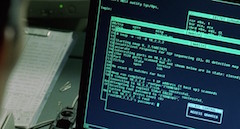class: center, middle # Introduction to UNIX I: Command Line --- # UNIX Command line * The UNIX Shell: command line interface * Navigating Directories and Files * Running applications --- class: left # Shell - Command Line Interface (CLI) .right[] * Interactive interface of UNIX operating system (Linux and OSX are a type of UNIX) * Access to this in the Terminal, or iTerm on OSX (since BSD-UNIX is under the hood) * Windows: Use [Cygwin](https://www.cygwin.com/). Windows10 does have a [BASH shell](https://www.windowscentral.com/how-install-bash-shell-command-line-windows-10). * The Shell is the commandline program. There are several types, * `sh` - Bourne shell * `bash` - Bourne again shell * `csh` - C shell --- # Anatomy of a command line ```shell /Users/me $ ls /Users/me $ date /Users/me $ ping www.ucr.edu /Users/me $ echo "hello there" /Users/me $ python test.py /Users/me $ python cmdline.py -i input -o out -d db ``` --- # Using CLI * Programs are run from the shell to interact with the filesystem, naviagate folders, read files * launch programs like file editors, --- # Reminders .right[] * Case MaTTerS * File Extensions (e.g. .txt .doc .docx) don't matter * Avoid spaces in filenames * Files starting with '.' are hidden by default --- # Directories and listing 1. ls - shows a listing of the files and folders ```shell $ ls $ ls -l ``` 3. ls -d will display a directory name only 4. ls -F will give a different symbol for directories 5. ls -l shows long listing 6. ls -lt shows long listing, ordered by newest to oldest 7. ls -a shows hidden files 7. How to know all the options? --- # Use `man` to find out more about a program ```shell $ man ls NAME ls -- list directory contents SYNOPSIS ls [-ABCFGHLOPRSTUW@abcdefghiklmnopqrstuwx1] [file ...] DESCRIPTION For each operand that names a file of a type other than directory, ls displays its name as well as any requested, associated information. ``` --- # Directories: Creating and Deleting 1. mkdir - make directory ```shell $ mkdir MyDir $ mkdir MyDir # will give warning $ mkdir MyDir/UnderDir/DeepDir # will not work, UnderDir not created $ mkdir -p MyDir/UnderDir/DeepDir # -p option will create intermediate one ``` 2. rmdir - remove directory ```shell $ rmdir MyDir # won't let you unless it is empty $ rmdir MyDir/UnderDir/DeepDir ``` --- # Navigating paths 1. to go into a directory use cd 2. to go back a level use 'cd ..' Can specify a total path 'cd /tmp' 3. To go back to your home dir, type cd 5. Try to make a dir, go into it, make another directory. 4. On the Mac you can see the same directories and files organized graphically too 5. SWCarpentry has a nice intro with graphics [here](https://swcarpentry.github.io/shell-novice/02-filedir/)  --- # Files 1. The whole point of all this is probably to create files with data 2. can make an empty file with ```shell $ touch file # will create an empty file ``` 3. Running programs can generate files 4. We will discuss output later but you can direct output of a program to create a file. ```shell $ echo "hello world" > hello.txt $ echo "goodbye cruel world" > goodbye.txt ``` --- # Permissions 1. ls -l will show a long version of listing output ```plain jstajich@pigeon:/bigdata/gen220/shared/data_files$ ls -l total 0 lrwxrwxrwx 1 jstajich gen220 25 Sep 25 13:53 Nc20H.expr.tab -> expression/Nc20H.expr.tab -rw-rw-r-- 1 jstajich gen220 609183 Sep 25 13:52 Spellman.csv drwxrwxr-x 2 jstajich gen220 4096 Jun 10 00:39 expression drwxr-xr-x 6 jstajich gen220 4096 Jun 10 00:39 sequences ``` 2. There is info on the file/folder and 3 sets of permissions listed there * 'd' -> It is a directory, 'l' -> it is a link, empty, it is a file * User -> rwx or rw- permissions for the user * Group * All 3. what are permissions * r - is it readable * w - is it writeable * x - is it executable 4. Directories have to be executable to be able to be used/entered. Programs/applications need to be executable to be able to run. --- # Deleting things (careful!) 1. rm - for removing files 2. rm -r -- _be careful_ removes recursively 3. rm -f - removes without prompting you 4. rm -rf - removes recurisvely without prompty __Use with care__ --- # File content Want to read the content of a text file you can use these commands 1. cat - will spit out the whole file on the screen 2. more - a paginator - will display one page at a time (based on your screen) 3. less - similar to more, but has additional options --- # Editors 1. pico or nano * Will be one of the easiest to try out on the command line * Follow commands at bottom of screen to figure out how it works 2. emacs, vi 3. TextEdit, TextMate on OSX 4. Syntax highlighting useful when doing programming. We will do more on this later. --- # Other resources 1. [Introduction to UNIX Shell - Software Carpentry](https://swcarpentry.github.io/shell-novice/)